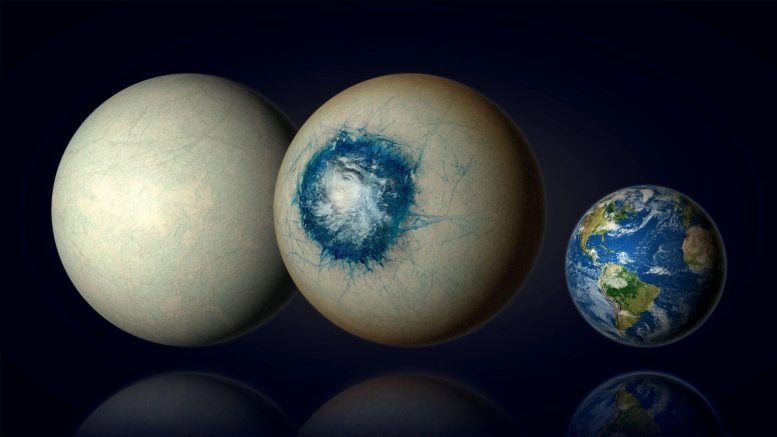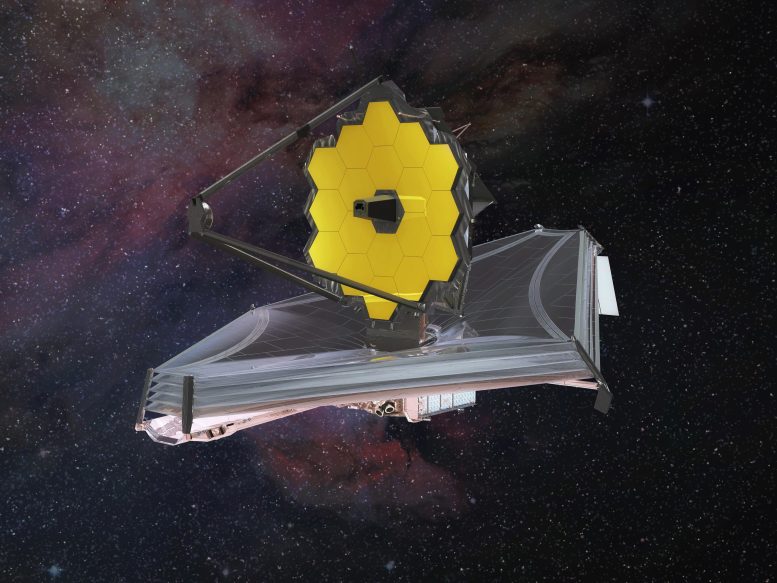
A team of astronomers has made an exciting discovery about the temperate exoplanet LHS 1140 b: it could be a promising “super-Earth” covered in ice or water.
LHS 1140 b, once thought to be a mini-Neptune, is now considered a possible super-Earth with a nitrogen-rich atmosphere, as suggested by James Webb Space Telescope data. Located in a habitable zone, it may have conditions favorable for liquid water, making it a key focus for future astrobiological studies.
When it was first discovered, astronomers speculated that the exoplanet LHS 1140 b might be a mini-Neptune. This means it would be an essentially gaseous planet, but very small in size compared to Neptune. However, after analyzing data from the James Webb Space Telescope (JWST) collected in December 2023 — combined with previous data from other space telescopes such as Spitzer, Hubble, and TESS — scientists have come to a very different conclusion.
Located about 48 light-years from Earth in the constellation Cetus, LHS 1140 b appears to be one of the most promising exoplanets in its star’s habitable zone, potentially harboring an atmosphere and even an ocean of liquid water. The results of this discovery by Université de Montréal astronomers are available on ArXiv and will soon be published in The Astrophysical Journal Letters.

An Exoplanet in the ‘Goldilocks’ Zone’
LHS 1140 b, an exoplanet orbiting a low-mass red dwarf star roughly one-fifth the size of the Sun, has captivated scientists due to it being one of the closest exoplanets to our Solar System that lies within its star’s habitable zone. Exoplanets found in this “Goldilocks’ Zone” have temperatures that would allow water to exist on them in liquid form — liquid water being a crucial element for life as we know it on Earth.
Earlier this year, researchers led by Charles Cadieux, a Ph.D. student at UdeM’s Trottier Institute for Research on Exoplanets (iREx) supervised by professor René Doyon, reported new mass and radius estimates for LHS 1140 b with exceptional accuracy, comparable to those of the well-known TRAPPIST-1 planets: 1.7 times the size of Earth and 5.6 times its mass.

One of the critical questions about LHS 1140 b was whether it is a mini-Neptune type exoplanet (a small gas giant with a thick hydrogen-rich atmosphere) or a super-Earth (a rocky planet larger than Earth). This latter scenario included the possibility of a so-called “Hycean world” with a global liquid ocean enveloped by a hydrogen-rich atmosphere which would exhibit a distinct atmospheric signal that could be observed using the powerful Webb Telescope.
New Insights From Webb Data
Through an extremely competitive process, the team of astronomers obtained valuable “director’s discretionary time” (DDT) on Webb last December, during which two transits of LHS 1140 b were observed with the Canadian-built NIRISS (Near-Infrared Imager and Slitless Spectrograph) instrument. This DDT program is only the second dedicated to the study of exoplanets in the nearly two years of Webb’s operations, underscoring the importance and potential impact of these findings.
Analysis of these observations strongly excluded the mini-Neptune scenario, with tantalizing evidence suggesting exoplanet LHS 1140 b is a super-Earth that may even have a nitrogen-rich atmosphere. If this result is confirmed, LHS 1140 b would be the first temperate planet to show evidence of a secondary atmosphere, formed after the planet’s initial formation.
Estimates based on all accumulated data reveal that LHS 1140 b is less dense than expected for a rocky planet with an Earth-like composition, suggesting that 10 to 20 percent of its mass may be composed of water. This discovery points to LHS 1140 b being a compelling water world, likely resembling a snowball or ice planet with a potential liquid ocean at the sub-stellar point, the area of the planet’s surface that would always be facing the system’s host star due to the planet’s expected synchronous rotation (much like the Earth’s Moon).

“Of all currently known temperate exoplanets, LHS 1140 b could well be our best bet to one day indirectly confirm liquid water on the surface of an alien world beyond our Solar System,” said Cadieux, lead author of the new study. “This would be a major milestone in the search for potentially habitable exoplanets.”
Possible Presence of an Atmosphere and an Ocean
While it is still only a tentative result, the presence of a nitrogen-rich atmosphere on LHS 1140 b would suggest the planet has retained a substantial atmosphere, creating conditions that might support liquid water. This discovery favors the water-world/snowball scenario as the most plausible.
Current models indicate that if LHS 1140 b has an Earth-like atmosphere, it would be a snowball planet with a vast “bull’s-eye” ocean measuring about 4,000 kilometers in diameter, equivalent to half the surface area of the Atlantic Ocean. The surface temperature at the center of this alien ocean could even be a comfortable 20 degrees Celsius.
LHS 1140 b’s potential atmosphere and favorable conditions for liquid water make it an exceptional candidate for future habitability studies. This planet provides a unique opportunity to study a world that could support life, given its position in its star’s habitable zone and the likelihood of its having an atmosphere that can retain heat and support a stable climate.
Several Years of Observation Ahead
Confirming the presence and composition of LHS 1140 b’s atmosphere and discerning between the snowball planet and bull’s-eye ocean planet scenarios require further observations. The research team has emphasized the need for additional transit and eclipse measurements with the Webb Telescope, focusing on a specific signal that could unveil the presence of carbon dioxide. This feature is crucial for understanding the atmospheric composition and detecting potential greenhouse gases that could indicate habitable conditions on the exoplanet.
“Detecting an Earth-like atmosphere on a temperate planet is pushing Webb’s capabilities to its limits – it’s feasible; we just need lots of observing time,” said Doyon, who is also the principal investigator of the NIRISS instrument. “The current hint of a nitrogen-rich atmosphere begs for confirmation with more data. We need at least one more year of observations to confirm that LHS 1140 b has an atmosphere, and likely two or three more to detect carbon dioxide.” According to Doyon, the Webb Telescope will likely have to observe this system at every possible opportunity for several years to determine whether LHS 1140 b has habitable surface conditions.
Given LHS 1140 b’s limited visibility with Webb — a maximum of only eight visits per year are possible — astronomers will require several years of observations to detect carbon dioxide and confirm the presence of liquid water on the planet’s surface.
Reference: “Transmission Spectroscopy of the Habitable Zone Exoplanet LHS 1140 b with JWST/NIRISS” by Charles Cadieux, René Doyon, Ryan J. MacDonald, Martin Turbet, Étienne Artigau, Olivia Lim, Michael Radica, Thomas J. Fauchez, Salma Salhi, Lisa Dang, Loïc Albert, Louis-Philippe Coulombe, Nicolas B. Cowan, David Lafrenière, Alexandrine L’Heureux, Caroline Piaulet, Björn Benneke, Ryan Cloutier, Benjamin Charnay, Neil J. Cook, Marylou Fournier-Tondreau, Mykhaylo Plotnykov, Diana Valencia, Accepted, The Astrophysical Journal Letters.
arXiv:2406.15136
Cadieux is a doctoral student at Université de Montréal’s Trottier Institute for Research on Exoplanets (iREx).
Other iREx researchers who contributed to this paper are René Doyon (UdeM), Étienne Artigau (UdeM), Olivia Lim (UdeM), Michael Radica (UdeM), Salma Salhi (UdeM), Lisa Dang (UdeM), Loïc Albert (UdeM), Louis-Philippe Coulombe (UdeM), Nicolas Cowan (McGill), David Lafrenière (UdeM), Alexandrine L’Heureux (UdeM), Caroline Piaulet-Ghorayeb (UdeM), Björn Benneke (UdeM), Neil Cook (UdeM), and Marylou Fournier-Tondreau (UdeM and University of Oxford). Additional contributors are based out of the University of Michigan, the Centre national de recherche scientifique (France), NASA Goddard Space Flight Center, the American University, McGill University, McMaster University, and the University of Toronto. Cadieux and the UdeM team acknowledge financial support from the Canadian Space Agency for this study.
1 Comment
Thats so close i could get a bus ride there.